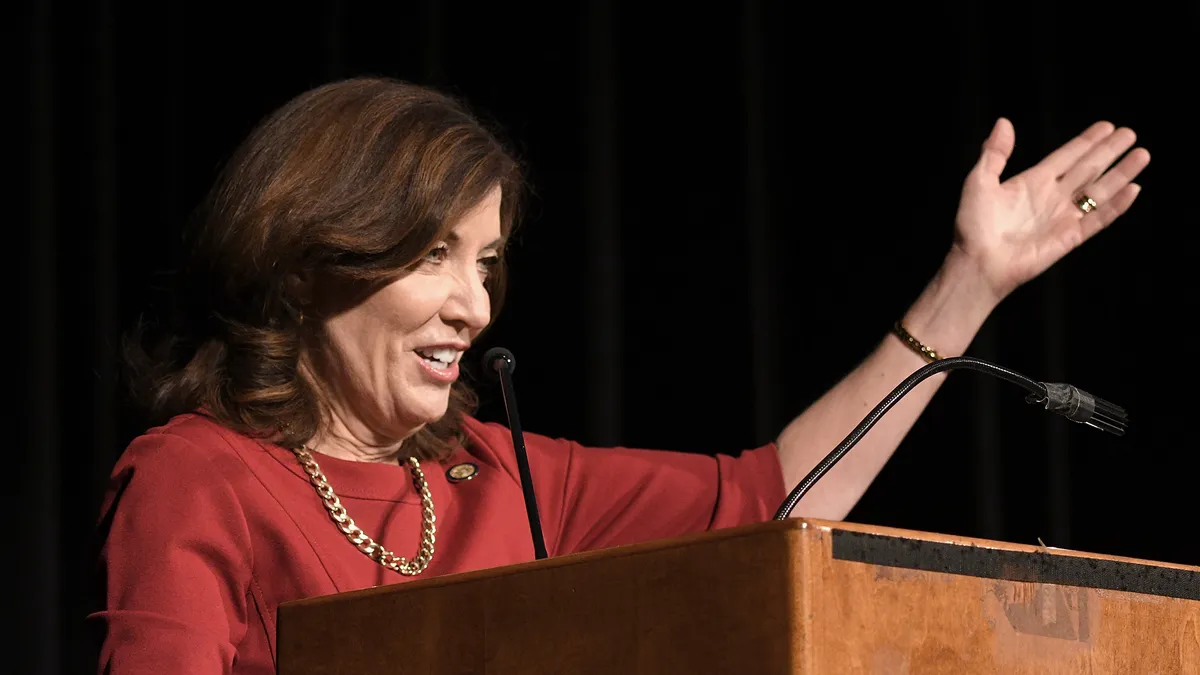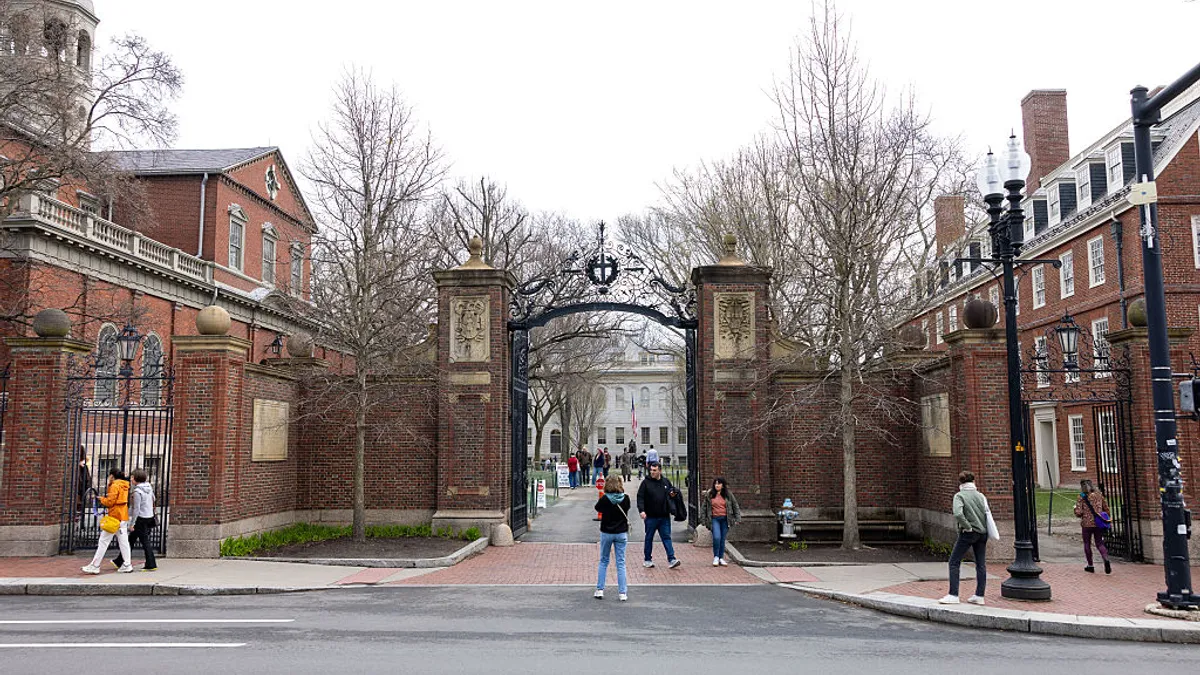In its 74-year existence, the State University of New York, the largest public comprehensive higher education system in the U.S., has often wrestled with addressing the competing interests of its 64 campuses, from the research-centric Stony Brook University to its dozens of community colleges.
And in the last decade or so, SUNY has suffered declining enrollment numbers, which the coronavirus pandemic exacerbated. SUNY competes in New York's saturated higher education market with nationally prominent institutions, such as Cornell and Columbia universities. State investment has been relatively flat during those years as well.
An ambitious plan unveiled Wednesday by the newly minted New York governor, Kathy Hochul, intends to reverse these trends, with an eye on boosting enrollment, emphasizing research opportunities and more clearly delineating roles of some institutions across the sprawling system.
Achieving those goals is another matter.
A new tiered system
Hochul, who announced her plans for the roughly 376,000-student system in conjunction with her State of the State address, wants to raise enrollment to 500,000 students — a formidable challenge considering it plunged by 20% in the past 10 years.
The Democratic governor is in part banking on a new stratified design of the system's colleges to help raise their profile.
She has designated Stony Brook and the University at Buffalo, two of the highest-enrolling institutions, as state flagship campuses. Each would aim to bring in $1 billion a year in federal research funding by 2030.
Hochul's office did not immediately respond to a request for comment Thursday.
To invigorate the two universities, the state will route about $100 million in capital funding to each new flagship so each can build a new engineering facility.
University at Albany and Binghamton University will also advance their research missions with the target of receiving $500 million each in federal research funding annually.
The elevation of these universities departs from the strategy employed by former SUNY Chancellor Nancy Zimpher, who retired in 2017. Zimpher underlined SUNY as an economic engine through her strategic plan, the Power of SUNY, but emphasized the system's power as a unit, rather than homing in on institutions' specializations.
Hochul is spearheading a tiering approach that exists in many other states' public university systems, said Brendan Cantwell, a higher education professor at Michigan State University. But SUNY has operated with a "systemness" mindset for so long that breaking it could prove challenging, Cantwell said.
"The faculty and the administrators at Albany and Binghamton likely view themselves as peers to Stony Brook and Buffalo, and I'm not sure how playing second-fiddle would fit," he said.
Observers have argued, however, that SUNY's one-size-fits-all model hampers the achievements of institutions such as Stony Brook. A New York Daily News editorial in 2011 described SUNY as being mired in "a culture of uniformity and mediocrity."
Specializing the universities' missions might also not align with a shifting labor market, said Rebecca Natow, an educational leadership and policy professor at Hofstra University, a private nonprofit institution on Long Island.
"If an institution really heavily invests in a particular field, and later there's less demand for those types of jobs, they may experience a decline in enrollment," Natow said.
'Aspirational' goals
A joint statement from officials at Stony Brook University and the University at Buffalo lauded the new flagship designation, saying it "acknowledges the excellence and reputations of our universities and it will further enhance our ability to continue to recruit the world’s most accomplished faculty and attract outstanding students."
The two SUNY universities are the only public institutions in New York with membership in the Association of American Universities, a coalition of leading research institutions.
Cantwell called the governor's goals for SUNY "aspirational," particularly the research funding targets for Stony Brook and Buffalo. Often, the colleges with funding close to the targeted $1 billion host vast medical centers, such as Johns Hopkins University, he said. SUNY campuses aren't as prominent nationally as those institutions, Cantwell said. Fewer than 20 institutions spent $1 billion on research and development in fiscal 2019.
The approach is "odd," Cantwell said. It reminded him of a strategy colleges might have attempted before the Great Recession. Postsecondary education has generally since moved away from research emphases and become more focused on college access, he said.
Hochul's plan contains elements geared toward college access, however. It calls for allowing prospective students to apply to all SUNY schools with a single process.
It also would expand student financial aid to part-time students through the New York State Tuition Assistance Program. That aims to tap a pool of adult and nontraditional college students, important groups given projections the pool of high school graduates will diminish in the state and nationally. The plan does not refer to New York's well-known Excelsior Scholarship program, which allows students to attend public colleges in the SUNY and City University of New York systems tuition free and was a trademark policy of Hochul's predecessor, Gov. Andrew Cuomo.
But the proposal does mention providing tuition-free programs leading to workforce credentials in high-demand fields at community colleges.
Middling state investment
The system's enrollment drop has coincided with a decade of essentially flat state funding, which was preceded by cuts, mirroring trends in other states. State appropriations to SUNY in recent years have ranged from a low of $3.3 billion in 2015-16 to a high of $3.7 billion in 2018-19.
Most of what Hochul is proposing cannot succeed without more state funding, Cantwell said.
In December, the union representing faculty and professional staff at SUNY, United University Professions, urged state lawmakers to provide at least $150 million in new operating funding for SUNY institutions.
UUP President Fred Kowal in a statement praised Hochul's plan, saying the union is "eager to work with her to break the pattern of 11 years of underfunding for SUNY."
The SUNY trustee board in a statement also applauded the governor's "visionary agenda," highlighting elements like the broadening of tuition assistance and targeting of adult students.
Other aspects of Hochul's strategy include helping five more institutions become minority-serving institutions by 2025 and simplifying the transfer process among SUNY colleges.
SUNY's chancellor, Jim Malatras, is due to step down Jan. 14. He resigned amid a scandal over revelations he made caustic comments about a woman who accused Cuomo of sexual harassment. Deborah Stanley, president of SUNY Oswego, will serve as his interim successor.






















